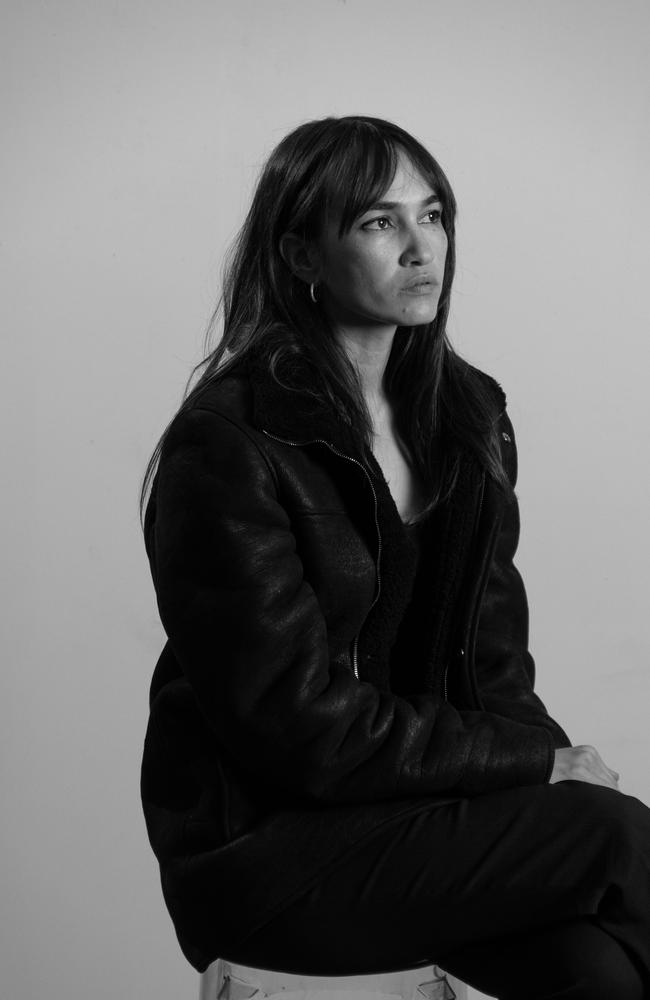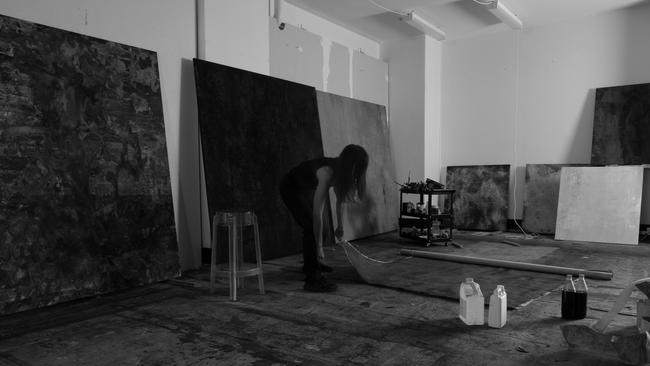Taylah Hasaballah’s paintings are built to decay
With her upcoming Sydney exhibition DIG, Hasaballah challenges art’s obsession with permanence, using chemical reactions and environmental influences to shape paintings that evolve over time.
When Sydney artist Taylah Hasaballah welcomes The Australian to her Ultimo studio, the first thing to notice is that her hands are completely blue. A run-in with some pigment, she explains.
For the past six weeks, Hasaballah, 30, has been holed up in her studio, working feverishly on paintings for her forthcoming exhibition, DIG. “It’s been hectic,” she laughs, playing down the intensity.
There’s a reason for the mad dash: just weeks earlier, Hasaballah and her partner, digital artist Tristan Jensen, were busy completing HEAT LOSS, an 11x4 metre, interactive installation for Mode Festival on Cockatoo Island. The work, documented through time-lapse video and thermal sensors, captured a series of Hasaballah’s paintings — made from metals, acids, and pigments — as they evolved and decayed over several weeks.

That tension between creation and decay lies at the heart of DIG, a series of works inspired by archaeological sites. “I had this idea during my last show, Signal to Noise, that a lot of the pieces looked like earth. They resembled topographical maps,” Hasaballah explains. “I wanted to expand on that and build it out in the context of a dig site.”
DIG builds on Hasaballah’s years-long investigation into entropy, the natural decay and transformation of matter over time. “Historically entropy appears as this devil that we had to fight against,” she explains.
“[The mathematician] Norbert Wiener had these ideas of entropy as a negative force, something to avoid. But if you recognise that entropy will inevitably affect everything — whether or not you’re happy about it — you can start to play around with the this architecture of decay.”

She believes much of traditional painting construction is about resisting entropy. “It’s trying to make things that will last forever and outlive us all. I was interested in what’s available to explore if you invert the archival dogma. What if you used entropy as a medium for expression, rather than this thing you’re trying to fight against?”
So she began experimenting with chemicals, meddling with mixtures of metal and powder pigments, turning copper into verdigris, letting the works react and change each other. The pieces respond to their environment, to time itself. “I’ve got them in my house, and it’s interesting to see a piece that you’re used to being a static thing on the wall change. It’s nice to have this thing that changes with you. That felt quite beautiful in a way.”

In practice, this means relinquishing control over materials once her initial interventions are complete. It involves precise control at the outset: imported linen— “like, Belgian linen primed in Italy, a beautiful sensitive surface” — laid out on a studio floor. Metals like iron or copper may provide the first layer, interacting invisibly with the air’s chemistry. Then there are powder pigments: dusted, poured, sometimes scraped, sometimes pooled.
The control ends there. Everything afterwards is left to gravity, weather, and the peculiarities of place: slopes in the floorboards that pull liquid downward, and environments that warp the drying process. The alleyway in Marrickville, where her old studio was, left marks of its own — pebbled abrasions and textural scrapes from the ground. “That’s what makes it interesting to change space for me,” she explains. “You learn the idiosyncrasies of the floor, the room, where things pool and settle.”

In her finished works, crystals often form where chemicals settle thickly, and subtle patterns bloom where the environment intruded most. “Everything that’s a limitation can also be used to your advantage,” she says.
Her experiments aren’t limited to canvas. At Australian Fashion Week, Hasaballah dyed fabrics for the label Speed, developing a process that combined industrial dyes with chemical reactions and ancient encaustic (wax) techniques.

Guiding The Australian through her studio, Hasaballah stops in front of a painting that is still wet. “This one will look quite different tomorrow,” she says. Does she have any way of predicting how it will change? “I do now, just from doing it so many times. With this one, the materials used will create more of a dendrite crystal lattice. In a sense, I’m controlling the painting using the chemicals I’m combining and how I apply them.”

This chemical experimentation — is it dangerous? “The individual chemicals I work with are safe,” she says. “The only thing I have to watch out for is the gases they initially emit when first combined” she adds, pointing to a rather daunting respirator mask.
Hasaballah began pursuing painting seriously at 24, creatingworks using seed oil on linen. “All from the same plant, it was so pure!” But the pristine work she was producing started to feel disingenuous. “It was like, ‘How can I pretend this perfect, pristine state exists when it so evidently doesn’t?’”

In response, she set herself a challenge: to paint nothing. “I thought it would feel more real, taking myself out of the painting,” she explains. But painting nothing is harder than it sounds. “Your subconscious kicks in, and all of these other things happen. So eventually that led me to explore the question — to what extent can the artist relinquish control to nature?”
DIG opens December 21 at the former COMA Gallery space in Chippendale.

